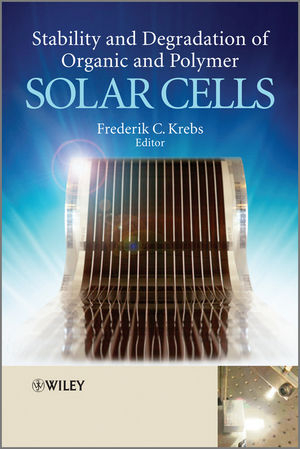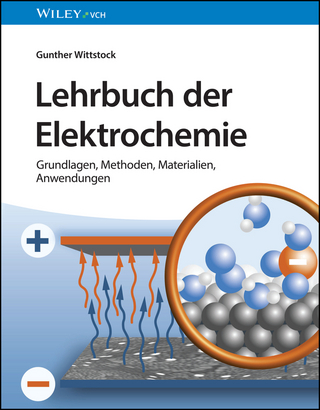
Stability and Degradation of Organic and Polymer Solar Cells
John Wiley & Sons Inc (Verlag)
978-1-119-95251-0 (ISBN)
- Titel z.Zt. nicht lieferbar
- Versandkostenfrei innerhalb Deutschlands
- Auch auf Rechnung
- Verfügbarkeit in der Filiale vor Ort prüfen
- Artikel merken
Topics covered include:
Chemical and physical probes for studying degradation
Imaging techniques
Photochemical stability of OPV materials
Degradation mechanisms
Testing methods
Barrier technology and applications
Stability and Degradation of Organic and Polymer Solar Cells is an essential reference source for researchers in academia and industry, engineers and manufacturers working on OPV design, development and implementation.
Professor Frederik Krebs is based at the Riso National Laboratory for Sustainable Energy in Denmark where he is part of the Solar Energy Program. The aim of the program is to synthesize new materials for light harvesting and to optimize the structure of the solar cell with regards to energy conversion, stability and cost. Professor Krebs has been working in the field of polymer solar cells for over 10 years, focusing his efforts on the materials, manufacture and stability of solar cells. His research group are international pioneers, leading the way in their work on organic and polymeric solar cells. He has authored more than 200 publications, has written 2 books on organic photovoltaics (OPVs) and has hosted a conference on the stability of polymer solar cells (ISOS-3 International Summit on OPV Stabilty). He has also edited many journal special issues on organic photovoltaics, including one dedicated to their stability. In 2009, Professor Krebs received the Carlsberg Energy Research Prize in recognition of his work in polymer solar cells.
Preface xi
Acknowledgements xiii
List of Contributors xv
1. The Different PV Technologies and How They Degrade 1
Frederik C. Krebs
1.1 The Photovoltaic Effect and the Overview 1
1.2 The Photovoltaic Technologies 2
1.3 Intrinsic Versus Extrinsic Stability 3
1.3.1 Intrinsic Stability 3
1.3.2 Extrinsic Stability 3
1.4 Degradation – The Culprits, the What, the Why and the How 3
1.5 Some Representative Technologies and How They Degrade 4
1.5.1 Mono- and Polycrystalline Silicon Solar Cells 5
1.5.2 Amorphous, Micro- and Nanocrystalline Silicon Solar Cells 6
1.5.3 CIS/CIGS Solar Cells 8
1.5.4 CdS/CdTe Solar Cells 9
1.5.5 Dye-Sensitized Solar Cells (DSSC) 10
1.5.6 Organic and Polymer Solar Cells (OPV) 11
2. Chemical and Physical Probes for Studying Degradation 17
Birgitta Andreasen and Kion Norrman
2.1 Introduction 17
2.2 Physical Probes 18
2.2.1 UV-vis Spectroscopy 18
2.2.2 Atomic Force Microscopy (AFM) 18
2.2.3 Interference Microscopy 20
2.2.4 Scanning Electron Microscopy (SEM) 21
2.2.5 Fluorescence Microscopy 23
2.2.6 Light-Beam Induced-Current Microscopy (LBIC) 24
2.2.7 Electroluminescence and Photoluminescence Imaging Microscopy (ELI and PLI) 25
2.2.8 X-ray Reflectometry 26
2.3 Chemical Probes 27
2.3.1 Infrared Spectroscopy (IR) 27
2.3.2 Time-of-Flight Secondary Ion Mass Spectrometry (TOF-SIMS) 28
2.3.3 X-ray Photoelectron Spectroscopy (XPS) 32
2.4 Summary and Outlook 35
3. Imaging Techniques for Studying OPV Stability and Degradation 39
Marco Seeland, Roland R¨osch and Harald Hoppe
3.1 Introduction to Imaging Techniques 39
3.1.1 Microscopy and Optical Scanning 39
3.1.2 Luminescence Imaging 40
3.1.3 Lock-In Thermography 43
3.1.4 Light-Beam Induced Current 45
3.2 Reports 46
3.2.1 Background: Degradation of OLED Devices 46
3.2.2 Light-Beam Induced Current 50
3.2.3 Luminescence Imaging 54
3.2.4 Optical Microscopy 57
3.2.5 Dark Lock-In Thermography and LBIC 58
3.2.6 Dark Lock-In Thermography and Optical Scanning for Failure Analysis 62
3.3 Discussion: Comparison of Imaging Techniques 63
3.4 Summary 66
4. Photochemical Stability of Materials for OPV 71
Matthieu Manceau, Agnes Rivaton and Jean-Luc Gardette
4.1 Introduction 71
4.2 Methods 72
4.2.1 Aging Condition 72
4.2.1.1 Natural and Artificial Accelerated Aging 72
4.2.1.2 Temperature Effect 73
4.2.1.3 Atmosphere Composition 74
4.2.2 Degradation Monitoring 74
4.2.2.1 Spectroscopies 75
4.2.2.2 Microscopies 80
4.3 State-of-the-Art 82
4.3.1 Degradation of the π-Conjugated Polymer 82
4.3.1.1 Study of the Pioneers: MDMO-PPV and P3HT 82
4.3.1.2 Material Chemical Structure vs. Material Stability 90
4.3.2 Acceptor Material Aging and Blend Degradation 99
4.3.2.1 Acceptor Degradation 99
4.3.2.2 Blend Degradation 99
5. Degradation of Small-Molecule-Based OPV 109
Martin Hermenau, Moritz Riede and Karl Leo
5.1 Comparison to Small-Molecule OLEDs 110
5.1.1 Number of Photoexcitations per Molecule 113
5.2 Comparison to Polymer Solar Cells 115
5.2.1 Sensitivity to Air 115
5.2.2 Temperature Stability 115
5.3 Small-Molecule Organic Materials 116
5.3.1 Active Materials 116
5.3.1.1 Fullerene C60 116
5.3.1.2 Phthalocyanines 117
5.3.1.3 Pentacene 117
5.3.2 Transport- and Exciton-Blocking Materials 119
5.3.2.1 Electron-Transport Materials 119
5.3.2.2 Hole-Transport Materials 123
5.4 Degradation Conditions 125
5.4.1 Oxygen and Water 125
5.4.2 UV Radiation 132
5.5 State-of-the-Art in Lifetime Studies 134
5.6 Summary and Outlook 138
6. Degradation of Polymer-Based OPV 143
Mikkel Jørgensen and Frederik C. Krebs
6.1 Focus on the Degradation and Stability of Polymer Solar Cells 143
6.2 A Chart of Degradation and Stability of Polymer Solar Cells 143
6.3 A Short Account of the OPV Stability/Degradation History 144
6.3.1 The Divisions of Degradation Mechanisms 146
6.3.2 The Methodologies 148
6.4 Modus Operandi for Evolving OPV 148
6.5 The Recent Developments 149
6.5.1 The Photocatalytic Oxides 149
6.5.2 Interlayers 150
6.5.3 The Inverted Structure 151
6.5.4 R2R Processing 152
6.5.5 Lamination and Encapsulation 153
6.5.6 Water Processing 154
6.5.7 Mechanical Degradation – Delamination 155
6.6 Interlaboratory Studies and Round Robins 156
6.7 Outside Studies 157
6.8 How Far Can OPV Be Taken in Terms of Stability 158
7. Test Equipment for OPV Stability 163
Olivier Haillant
7.1 Introduction 163
7.2 Reliability and Durability Testing of PV Products 165
7.2.1 Reliability, a Function of Durability 165
7.2.2 Environmental Durability 166
7.2.3 Durability and Weathering Testing 167
7.3 Laboratory Weathering Testing 168
7.3.1 Acceleration 168
7.3.2 Relevance 169
7.3.3 Precision 170
7.3.4 Introduction to Determination of Acceleration Factors 170
7.3.4.1 Acceleration of Photochemically and Thermally
Activated Processes 171
7.3.4.2 Acceleration Related to Thermal Fatigue 171
7.4 Durability Testing Techniques 172
7.4.1 Outdoor Weathering 172
7.4.1.1 Static and Dynamic Outdoor Exposure 172
7.4.1.2 Accelerated Outdoor Exposure 174
7.4.1.3 Companies Servicing Outdoor Exposure 175
7.4.2 Laboratory Weathering 175
7.4.2.1 Introduction 175
7.4.2.2 Filtered xenon arc 178
7.4.2.3 Metal Halide 179
7.4.3 Laboratory Photoaging 180
7.4.3.1 Mercury Arc 180
7.4.3.2 Fluorescent UV Lamps 181
7.4.4 Others 183
7.4.4.1 Light-Soaking Techniques 183
7.4.4.2 UV Concentrators 183
7.4.4.3 Carbon Arc 185
7.5 Conclusion 185
8. Characterization and Reporting of OPV Device Lifetime 193
Suren A. Gevorgyan
8.1 Introduction 193
8.2 Photoelectric Characterization of OPV Devices 194
8.2.1 Photoelectric Characterization Tools 194
8.2.2 Characterization in Controlled Environments 197
8.3 Interlaboratory Studies of OPVs 202
8.3.1 Introduction 202
8.3.2 Interlaboratory Studies of Flexible Large-Area Roll-to-Roll Processed Polymer Solar Cell Modules 203
8.3.3 Interlaboratory Stability Studies of OPVs 204
8.4 Lifetime Testing and Reporting: Standardized Approach 213
8.4.1 Introduction 213
8.4.2 Procedures for Standard Lifetime Measurements 214
8.4.3 Reporting Lifetime 235
8.5 Conclusions 238
9. Concentrated Light for Organic Photovoltaics 243
By Thomas Tromholt
9.1 Introduction 243
9.2 Light-Concentration Setups 245
9.2.1 Refractive Sunlight Concentration 245
9.2.2 Reflective Sunlight Concentration 246
9.2.3 Concentrated Solar Simulation 249
9.3 Experimental Work Performed with Concentrated Light 251
9.3.1 IPV Response to Concentrated Sunlight 251
9.3.2 Polymer Response to Concentrated Light 253
9.3.3 Organic Solar Cell Response to Concentrated Light 257
9.4 Physical Characterization by Concentrated Sunlight 261
9.5 Conclusion 265
10. Barrier Technology and Applications 269
Lars Muller-Meskamp, John Fahlteich and Frederik Krebs
10.1 Encapsulation Requirements 269
10.1.1 Types of Encapsulation 270
10.1.2 Glass/Glass Encapsulation 271
10.1.3 Lamination of Barrier Films 272
10.1.4 Thin-Film Encapsulation 273
10.1.5 Perimeter Sealing 273
10.2 Thin-Film Permeation Physics 274
10.2.1 Solid-State Diffusion and Diffusion in Polymers 274
10.2.2 Fick's First Law of Diffusion 275
10.2.3 Sorption 276
10.2.4 Permeation in Thin Films 277
10.2.5 Models for the Permeation-Coated Polymer Films 278
10.2.6 Temperature Dependence of Permeation 279
10.2.7 Dependence of Water Permeation on Layer Thickness 280
10.2.8 Time Dependence of Permeation 282
10.2.9 Permeation in Multilayer Barriers 284
10.2.10 Pinholes in Multilayer Systems 287
10.3 Measurement of Barrier Properties 288
10.3.1 Gravimetric Cup 289
10.3.2 Carrier-Gas-Based Coulometric Barrier Measurement 289
10.3.3 Mass Spectrometer 290
10.3.4 Direct Pressure Measurement 291
10.3.5 Radioactive Isotopes 292
10.3.6 Calcium Test (Optical or Electrical) 293
10.3.7 Device Testing 294
10.3.8 Standards and Typical Measurement Conditions 295
10.3.9 Test Method Overview 295
10.4 Barrier Technologies 295
10.4.1 Single-Layer Technologies 297
10.4.1.1 Reactive Evaporation 297
10.4.1.2 Magnetron Sputtering 298
10.4.1.3 Plasma-Assisted Chemical Vapor Deposition (PECVD) 302
10.4.1.4 Atomic-Layer Deposition (ALD) 306
10.4.1.5 Summary of Single-Layer Technologies 309
10.4.2 Multilayer Technologies 309
10.5 Barrier Application in OPV 315
10.5.1 Products 316
10.5.2 Barrier Cost and Manufacturability 318
10.6 Conclusion 321
References 322
11. Summary and Outlook 331
Frederik C. Krebs
Index 333
| Verlagsort | New York |
|---|---|
| Sprache | englisch |
| Maße | 173 x 247 mm |
| Gewicht | 721 g |
| Themenwelt | Naturwissenschaften ► Chemie ► Physikalische Chemie |
| Technik ► Elektrotechnik / Energietechnik | |
| Technik ► Maschinenbau | |
| ISBN-10 | 1-119-95251-4 / 1119952514 |
| ISBN-13 | 978-1-119-95251-0 / 9781119952510 |
| Zustand | Neuware |
| Haben Sie eine Frage zum Produkt? |
aus dem Bereich


